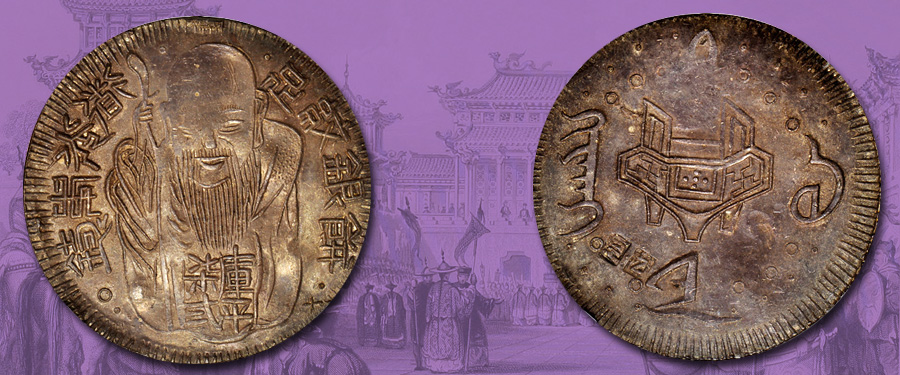
In 1837, during the reign of Emperor Tao Kwang, a rebellious general named Chang Wen staged a revolution in Taiwan. Chang Wen, the self styled “Commander-in-Chief of The Restoration Army of the Great Ming Dynasty,” would ultimately fail to achieve said restoration, but he would forever impact Chinese silver coinage. Any and all revolutionary coups require adequate financing to pay the soldiers, and due to Taiwan’s relative isolation as an island, Chang Wen decreed a silver coin of dollar size be struck, with comparable size to the Spanish 8 Reales. The inaugural Chinese silver dollars contained a remarkably high silver content, approximately 98% fine. This is extraordinary when compared to the most widely accepted silver dollar at the time, the Spanish 8 Reales, which had a silver content of approximately 90%.
The “Old Man” Dollar earned its moniker from the portraiture of the coin, depicting Shou-hsin, the god of longevity. Naturally, he is well advanced in age, and appears standing, clothed in a robe and holding a staff. The left inscription reads: “Cast in the time of Tao Kwang.” The weight (and by association to the Tael, its value) is depicted on the right side: “Seven Two by the Treasury scales.” This weight corresponded to .72 of a Tael, and later became the standard for the Imperial Dragon silver dollar coinage with a value of 7 Mace 2 Candareen. The final obverse inscription, located on the bottom of Shou-hsin’s robe, reads: “Silver cake of the standard purity.” This last inscription attests to the purity of the silver, an attribute that helped establish its credibility with local merchants and the general populace.
A “tsu” or sacrificial urn, as described in Kann, dominates the reverse. This tripod object has also been described as a treasure container. Four Manchu characters surround this item. The top and bottom characters signify “Formosa (Taiwan)”. The left and right inscriptions, according to Kann, indicate the town and treasury. Nearly every issue of this type contains an incised rectangular marking on the lower part of the reverse, which is widely interpreted as the maker’s mark. In addition to this maker’s mark, nearly all “Old Man” Dollars are found in average to low condition and, more often than not, heavily chopmarked. This example is of stellar condition for this type, with only a small number of scattered chopmarks that do not mar the inscriptions or designs. In addition to the relatively few chopmarks, this piece has retained most of its luster. This piece stands out as being quite choice for its type, and is even featured as the plate coin (#1618) in Chinese Currency a Comprehensive Text by Fredrik Schjoth. Mandel acquired it in a private purchase from Virgil Hancock. This example of a well preserved and choice “Old Man Dollar” represents an important piece of Chinese numismatic history as the first Chinese-made silver dollar, and when this fact is paired with the prestige of the Edgar Mandel Collection, the value assigned to this piece should not be underestimated.
Look for this and other Asian numismatic rarities from the Edgar Mandel Collection in our April Hong Kong Sale. Preview this impressive coin along with the rest of our auction this March at the Stack’s Bowers and Ponterio office located in Irvine, California. For details please refer to the Auction Schedule/Details link under Current Auctions at www.StacksBowers.com. To schedule an appointment, please call 800.566.2580.





